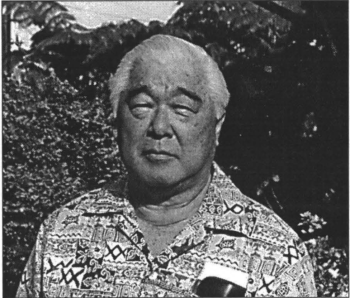Masao Uchima

Tsunamis Remembered: Oral Histories of Survivors and Observers in Hawai‘i
Life history interviews with individuals who witnessed and survived tsunamis-particularly the 1946 and 1960 disasters on the Big Island of Hawai'i. Thirty individuals-mostly residents of Hilo and Laupahoehoe-recall their experiences before; during, and after the 1946 and 1960 tsunamis which were arguably the most destructive natural disasters in modem Hawaiian history.
Masao Uchi.ma was born in Honoka'a, Hawai'i on May 22, 1928. When he was an infant, the family moved to 'O'okala, Hawai'i, where his father, Katsunoshin Uchima, was an independent sugarcane contractor. When Masao Uchima was five, the family moved to Hilo, where Katsunoshin Uchima began Eagle Laundry. The business was located on Kamehameha Avenue, in the Shinmachi section of Hilo. The family lived in a cottage behind the laundry. Katsunoshin Uchi.ma was an immigrant from Okinawa. His wife, Chidori Nishimoto Uchima, was born and raised in Honoka'a, Hawai'i. Masao Uchima, the second of four children, spent much of his childhood helping his parents in the laundry. When not working, he swam and fished in the nearby Wailoa River, and played in organized- sports leagues. A senior at Hilo High School at the time, Uchima was awakened by his mother on the morning of April 1, 1946. He found his home surrounded by water. As the water subsided, he and his father ran to the laundry, only to fmd the building badly damaged. They then ran to the nearby Coca-Cola Bottling Company building, a two-story, concrete structure. There they waited out the remaining waves in safety, while witnessing death and destruction around them. Eagle Laundry, as well as other businesses and residents of Shinmachi, was completely destroyed that day. After staying with relatives for a short while, Uchima and his family moved to converted military housing established for tsunami victims. Katsunoshin Uchima worked for a few years as a carpenter before his death in 1950. A few months after the tsunami, Masao Uchima graduated from Hilo High School. He worked for the Coca-Cola Bottling Company, Love's Bakery, and, beginning in 1955, was an insurance agent. He retired in 1982. He lives in Hilo with his wife, Mildred Nakasone Uchima. The couple raised two sons. Each year, the Uchimas plan and attend a Shinmachi remembrance service a:ild reunion held on the site of the once- thriving neighborhood, today the site of !Vailoa State Park.
Scope and Content Note
Raised in Shinmachi, a man recollects the area's close-knit families and sport and river-based activities. He details his family's laundry business and his chores: pressing, dry cleaning, and maintaining the boiler's pressure. He describes awakening on April 1, 1946 in a house surrounded by water and his family's escape to the nearby Coca-Cola concrete building, where they witnessed people swept to their deaths and the destruction of homes and businesses. Also discussed is the tsunami's aftermath, including identification of bodies and relocation of survivors.
Program Note:
This interview is part of the Center for Oral History's project Tsunamis Remembered: Oral Histories of Survivors and Observers in Hawai‘i. Interviews from this project are available in the Center's ScholarSpace open access repository.
The Center for Oral History (COH), in the Department of Ethnic Studies at the University of Hawaiʻi at Mānoa, collects, documents, preserves and highlights the recollections of Native Hawaiians and the multi-ethnic people of Hawaiʻi. It produces oral histories and interpretive historical materials about lifeways, key historic events, social movements and Hawaiʻi’s role in the globalizing world, for the widest possible use.
Please Note: The oral histories in this collection are protected by copyright and have been created for educational, research and personal use as described by the Fair Use Doctrine in the U.S. Copyright law. Please reach out Voices@noaa.gov to let us know how these interviews are being used in your research, project, exhibit, etc. The Voices staff can help provide other useful resources related to your inquiry.
The NOAA mission is to understand and predict changes in climate, weather, oceans, and coasts, to share that knowledge and information with others, and to conserve and manage coastal and marine ecosystems and resources. The Voices Oral History Archives offers public access to a wide range of accounts, including historical materials that are products of their particular times, and may contain offensive language or negative stereotypes.
Voices Oral History Archives does not verify the accuracy of materials submitted to us. The opinions expressed in the interviews are those of the interviewee only. The interviews here have been made available to the public only after the interviewer has confirmed that they have obtained consent.
